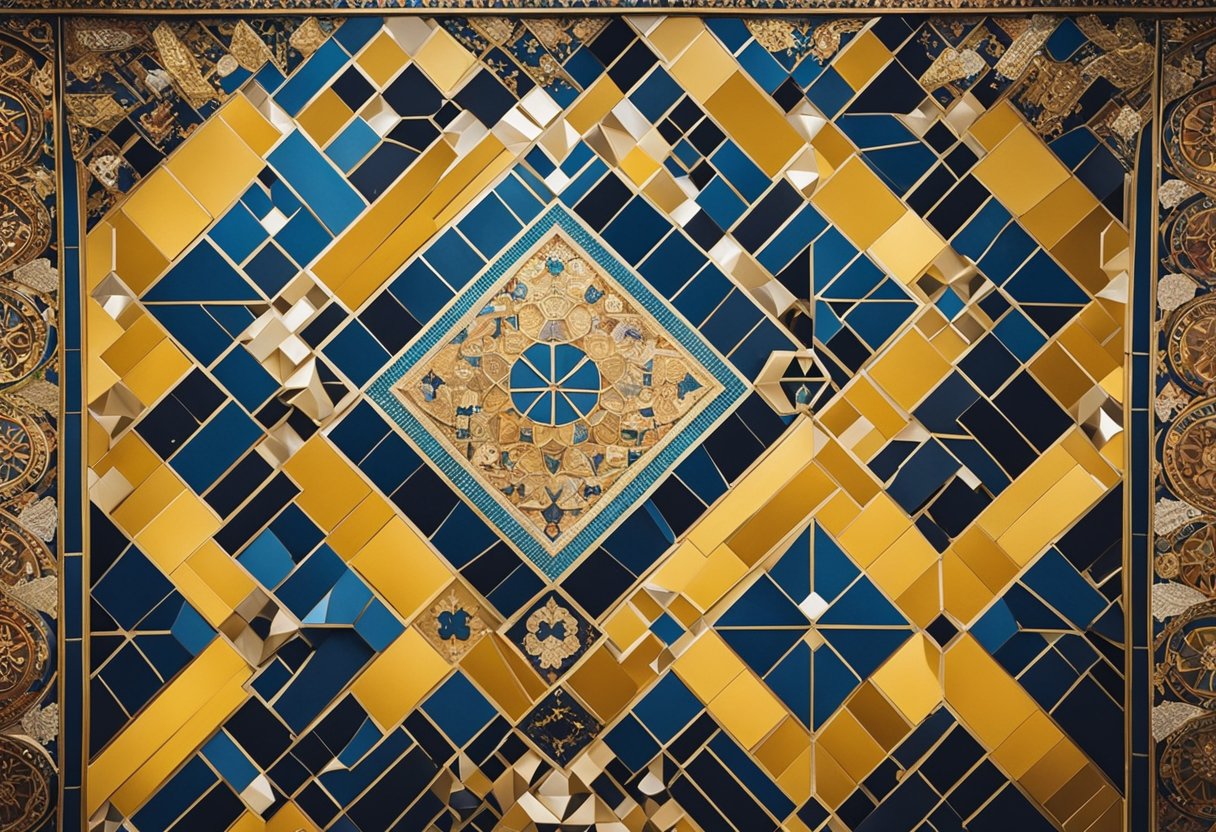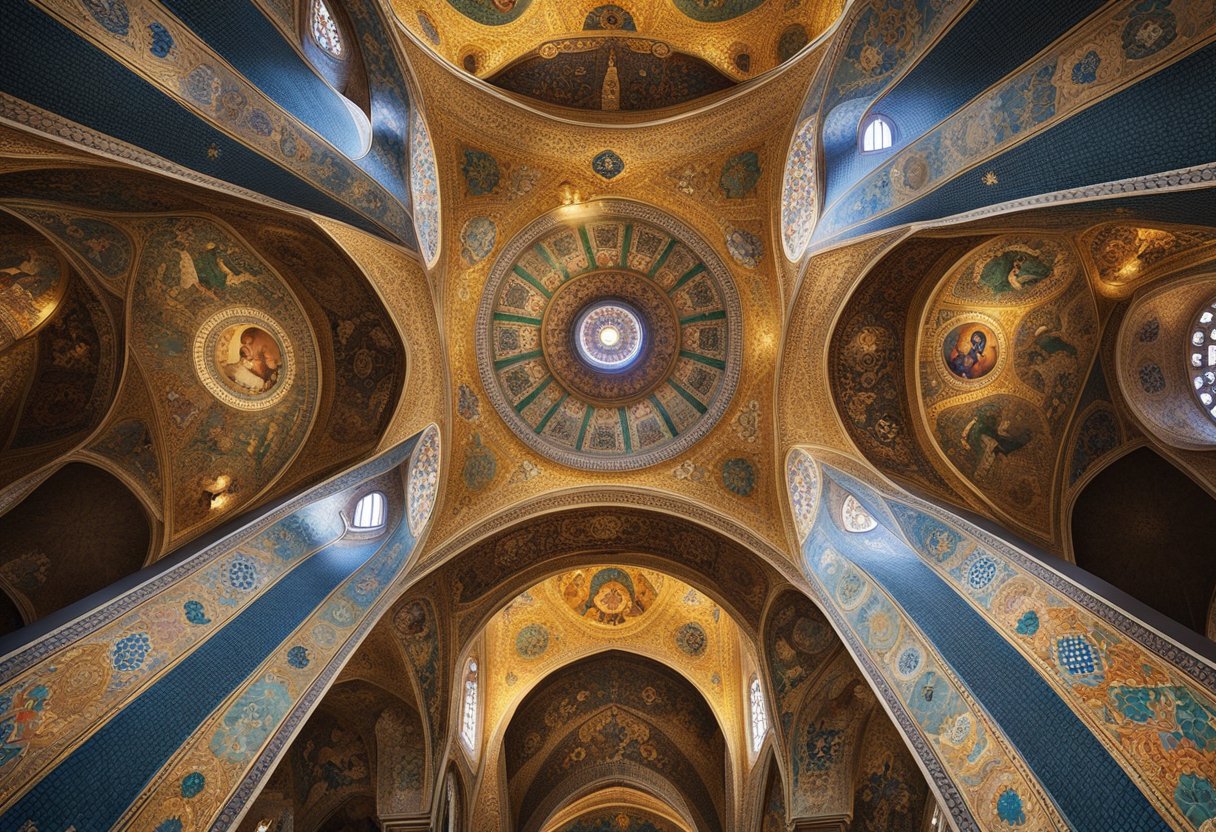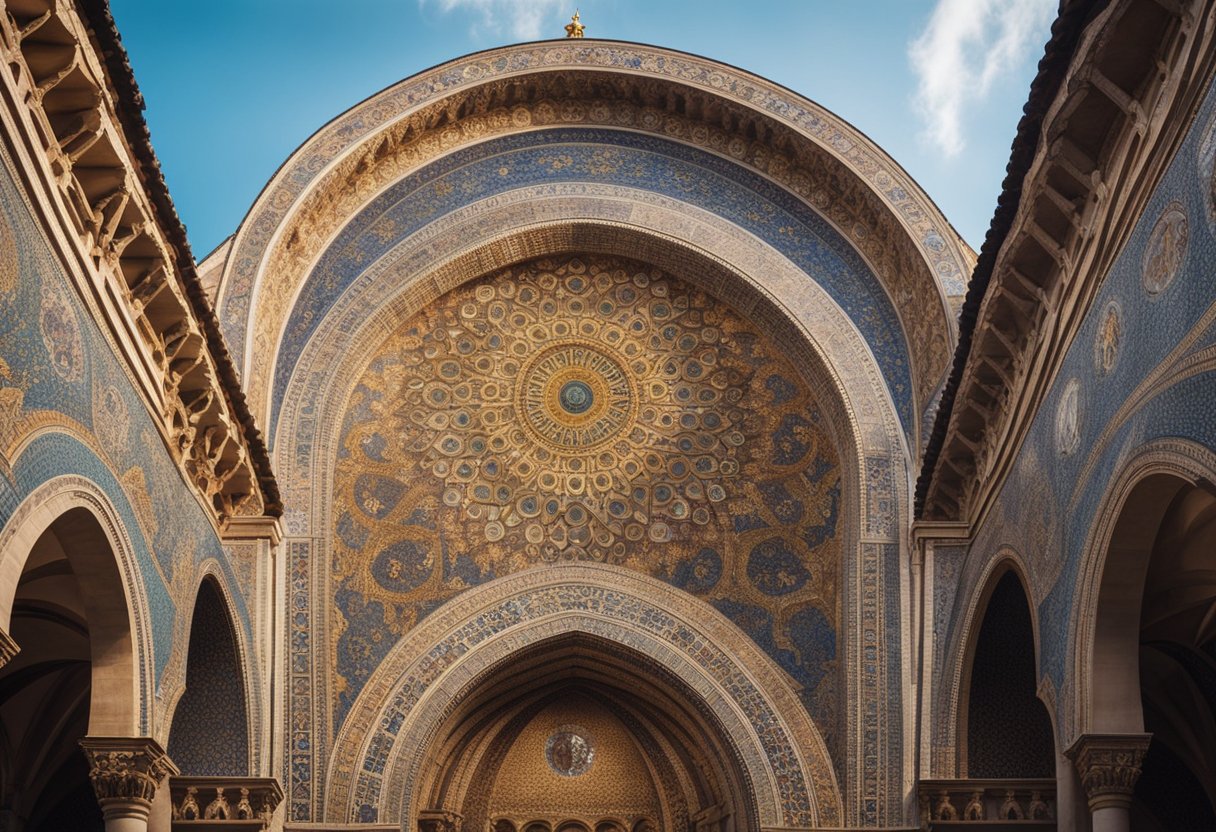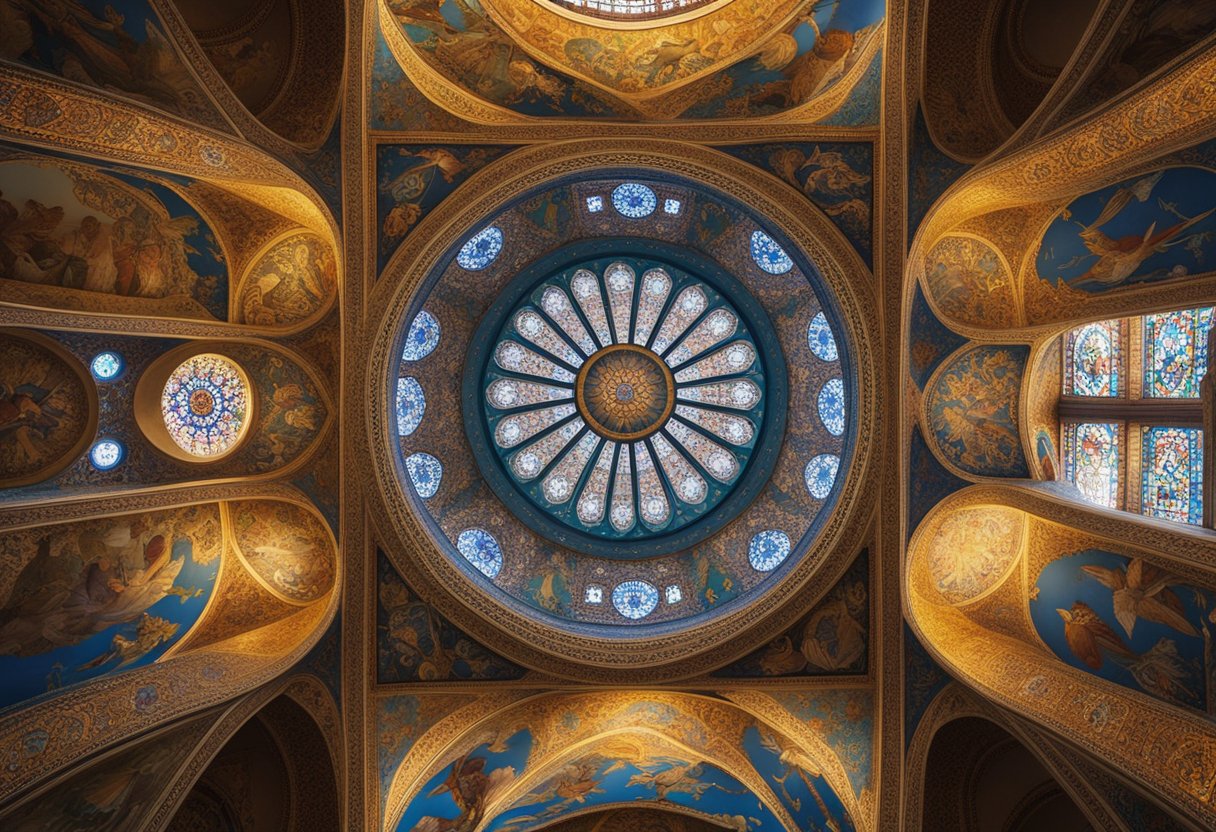The Mosaic Art of the Byzantine Empire: Discovering Timeless Splendour

Updated On: April 22, 2024 by Fatma Mohamed
Mosaic art forms a lustrous thread in the rich tapestry of Byzantine culture, highlighting both the artistic prowess and the deep religious sentiments of the Empire. From the 4th to the 15th centuries, Byzantine mosaics adorned the interiors of domes, walls, and vaults of many churches, presenting a fusion of architectural design and pictorial narratives. These intricate compositions, often crafted in the sacred spaces of such structures, reflected a visual language that communicated spiritual themes and imperial authority with each glass and stone tesserae.

The representation of divine figures and biblical scenes in mosaics provided not only decoration but also served as a liturgical and didactic tool for the viewers. Centrally displayed within domes, icons like Christ Pantocrator signified the omnipotence of the divine, asserting both religious belief and artistic ingenuity within the space. The legacy of Byzantine mosaics persists in their influence and preservation, providing insight into both the religious life and the aesthetic preferences of the Byzantine Empire.
Table of Contents
The Mosaic Art: Origins and Historical Context

The Byzantine Empire’s mosaic art is anchored in rich traditions that evolved from the Roman Empire. Our journey into this realm starts with the transformation from Roman to Byzantine art and centres on the establishment of Constantinople as the empire’s heart.
From Roman to Byzantine
As the mantle of artistic tradition passed from the ancients to the Byzantine era, mosaic art transitioned distinctly. In the early Byzantine period, mosaics were not merely decorative; they served as mediums of religious and cultural expression, integrating Hellenistic and Roman influences. The skillful compositions of natural pebbles that characterised Greek road-building laid the groundwork for advanced techniques, subsequently elevating the role of mosaics in both sacred and civic spaces.
Rise of Constantinople
Constantinople’s founding in 330 AD signified a pivotal moment for Byzantine art, with the city maturing into a cultural powerhouse. Here, mosaic art flourished, playing a key role in both religious and imperial iconography, a reflection of the city’s burgeoning status. Under Emperor Justinian I’s rule in the sixth century, the icons and monumental structures of Constantinople were emblazoned with intricate mosaics, synthesising artistry and piety, craftsmanship echoing through the Byzantine art canon for centuries to come.
Artistic Characteristics
Within the realm of Byzantine mosaic art, two key aspects stand out: the materials utilised in their creation, especially tesserae, and the deep symbolic meanings they conveyed through iconography.
Tesserae and Materials
We recognise Byzantine mosaics for their use of tesserae, small, cubic pieces often made of glass, stone, or marble. These tesserae were meticulously pieced together to form the grand images that decorated the walls and ceilings of Byzantine buildings. A significant feature is the inclusion of gold tesserae, which were not only a symbol of opulence but also played a crucial role in reflecting light, giving the mosaics a unique and ethereal glow that enhanced their beauty.
Symbolism and Iconography
Byzantine mosaics were steeped in symbolism. They were not mere ornaments; they were a visual language that communicated religious themes and stories to the observer. The icons depicted in these mosaics were often venerated as sacred, and the portrayal of holy figures was governed by specific symbolic conventions. The light was not just illumination; it was a symbol of the divine, and the way Byzantine art manipulated light through materials underpins its spiritual significance.
Religious Significance

In the Byzantine Empire, mosaic art held profound religious significance, reflecting the spiritual ethos and theological doctrines of the time. We see this especially in how mosaics were used in sacred spaces, depicting religious figures and narratives central to Orthodox Christianity.
Iconoclasm Controversy
During the 8th and 9th centuries, the Byzantine Empire experienced the Iconoclasm Controversy, a period of intense debate over the use of religious images. The Iconoclasts, those who opposed icons, believed that the creation and veneration of religious images was a form of idolatry forbidden by biblical commandments. They argued that holy figures, such as the Virgin Mary, should not be depicted in art as this could lead to the worship of the images themselves rather than the divine subjects they represented.
The Role of the Orthodox Church
Conversely, the role of the Orthodox Church was instrumental in endorsing and propagating the use of mosaics and icons in religious art. After the end of the Iconoclasm period, the church re-established the veneration of icons as a vital part of Orthodox worship. The church taught that these sacred images were a means to contemplate the divine and served as didactic tools used for educating the faithful. Mosaics adorned the interiors of domes and apses in churches across the empire, fostering a sense of the heavenly in the liturgical space and enhancing the spiritual experience of the worshippers.
Key Byzantine Mosaics
Our exploration into Byzantine mosaics uncovers a visual feast of historical and religious significance within the remnants of this great empire. The mastery of mosaic artistry is keenly evident in key sites such as Hagia Sophia -the great mosque nowadays- and the Church of San Vitale, where each tesserae tells a story of religious devotion, imperial power, and artistic innovation.
Hagia Sophia’s Splendour
Constructed in the 6th century originally as a cathedral, Hagia Sophia in present-day Istanbul represents a pinnacle of Byzantine architecture and mosaic art. Now it’s a turned to a mosque. Its interior surfaces are adorned with detailed mosaics that mesmerise visitors with their complexity and beauty. These mosaics, set against gold backgrounds, often depict religious figures and scenes, illustrating the empire’s strong Christian faith.
Church of San Vitale
The Church of San Vitale in Ravenna is another basilica renowned for its extraordinary collection of Byzantine mosaics. Considered one of the most intact examples of Byzantine art in Italy, San Vitale’s mosaics display a variety of religious images, including the famed depiction of Emperor Justinian and his attendants. The church’s octagonal structure showcases the adaptability of Byzantine mosaics within different architectural forms.
Through these edifices, we gain invaluable insights into the religious themes and artistic techniques of the time; their mosaics serve not only as sacred decoration but also as a testament to the Empire’s enduring influence on Christian iconography and church design.
Techniques and Workshops
In the Byzantine Empire, mosaic artistry reached exquisite levels of sophistication. Our focus here is on the intricate techniques of tessellation and the role of the artisan communities that sustained this grand tradition.
The Craftsmanship of Tessellation
The technique of tessellation involved arranging tiny pieces of material, known as tesserae, to form complete images. These tesserae were often made of glass or stone, cut into precise shapes to fit into the larger mosaic scheme. Glass tesserae allowed for a range of luminous colours and intricate details, while stone tesserae offered a more subtle textural variation and longevity.
Byzantium’s Artisan Communities
Workshops throughout the Byzantine Empire were the hubs of mosaic creation, each with a community of artisans dedicated to their craft. These artisans, some bearing the status of master craftsmen, pooled their skills and resources to create mosaics of religious and secular themes. Stone tesserae would be sourced locally, while glass tesserae were often imported, reflecting the trade networks that the workshops were part of. In these communities, techniques were refined over time, and the trade secrets of mosaic artistry were passed down through generations.
Expansion Beyond Byzantium

Byzantine art and mosaics, renowned for their spiritual beauty and intricate iconography, did not only flourish within the empire’s borders but also had a profound influence on regions far beyond, particularly during the Renaissance and across the Mediterranean basin.
Influence on the Renaissance
The fall of Constantinople in 1453 marked the end of the Byzantine Empire, but it was also a catalyst that propelled the treasures of Byzantine artistry into the heart of Europe, particularly Italy. Many Greek scholars and artists fled to Europe, bringing with them the rich traditions of Byzantine mosaics and iconography. This migration played a critical role in stimulating an interest in Greek philosophy and classical ideas, which laid the groundwork for the Renaissance, fundamentally shaping the direction of European art.
Byzantine Art in the Mediterranean
Byzantine aesthetics significantly influenced Mediterranean art forms, bridging East and West and leaving a visible trace on religious and secular art alike. Countries such as Greece and Russia incorporated Byzantine styles into their ecclesiastical decoration, with Russia, in particular, finding affinity in the spiritual intensity of Byzantine icons. Churches and cathedrals throughout the Mediterranean basin, from Sicily to the shores of North Africa, still bear the stylistic hallmarks of Byzantine influence, in both structure and ornamentation, showcasing the Byzantine Art in the Mediterranean‘s enduring appeal and cross-cultural reach.
Evolution of the Form
Mosaic art in the Byzantine Empire underwent significant transformation from the Early to Late Byzantine periods, adapting to changes in religious, political, and artistic contexts. We’ll examine this evolution, focusing on stylistic and thematic shifts that led into the Post-Byzantine era.
Early to Late Byzantine Periods
In the Early Byzantine period, mosaics were primarily influenced by Roman and Hellenistic traditions, featuring geometric designs and both religious and secular themes. By the Middle Byzantine, there was a marked shift towards more religious content, often displaying a golden background which created the impression of a divine realm. During what is referred to as the Macedonian Renaissance, a resurgence of classical themes intertwined with Christian iconography, artistry in mosaic works saw new heights with increased naturalism and expressive human figures.
Transitioning into the Late Byzantine period, mosaics displayed a blend of bold colours and intricate patterns. The art form continued to flourish, often reflecting the theological debates of the time, with a focus on monumental figures and a distinctive hierarchy in the depiction of religious characters. Despite the political turmoil of the era and the eventual fall of Constantinople to the Ottoman Empire, Byzantine mosaics remained a significant influence in many regions, exemplified by the persistence of mosaic artistry in countries under Byzantine cultural influence.
Transition to the Post-Byzantine Era
As the Ottoman Empire expanded, the religious and cultural landscape shifted dramatically, affecting the production and themes of mosaic art. Byzantine influence persisted through the Post-Byzantine period, particularly within the sphere of the Eastern Orthodox Church. Artistic expression found new routes, with mosaicists adapting to the changing times by integrating elements of Ottoman art while continuing the rich traditions of their Byzantine predecessors.
Mosaic art carried forth into the new era with adaptations that preserved the essence of its Byzantine roots, a testament to the enduring impact of the Byzantine aesthetic on subsequent cultures and artistic forms.
Notable Figures and Patrons

In the luminous era of the Byzantine Empire, mosaic art flourished largely due to the patronage of the imperial court and the pivotal role played by the church. Key figures of this time commissioned works that displayed religious figures and narrative scenes, which remain emblematic of Byzantine cultural achievement.
Emperor Justinian and Theodora
Justinian I reigned as emperor from 527 to 565 AD and, along with his wife Theodora, is remembered as one of the most significant patrons of Byzantine art and architecture. Justinian’s rule was marked by extensive building campaigns that included the construction of the magnificent Hagia Sophia – the current mosque-, whose mosaics set a new standard for religious art. A striking example is the Virgin and Child on a gold ground in Hagia Sophia, revealing the importance of iconography in Byzantine faith and culture.
Under Justinian and Theodora’s rule, mosaics were not simply decorative but served to convey imperial authority and divine sanction. Their depictions in the mosaics at the Basilica of San Vitale in Ravenna are among the most famous, embodying the grandeur and piety of the Byzantine court.
Preservation and Influence

In preserving the mosaic art of the Byzantine Empire, conservation efforts play a crucial role, ensuring these historical artefacts continue to inspire and impact modern art and scholarship.
Conservation Efforts
Historically significant, Byzantine mosaics have undergone meticulous conservation to prevent further deterioration. Organisations and institutions like Dumbarton Oaks have been pivotal in these efforts. Through archaeology and restorative interventions, they help maintain the integrity of these artworks. These activities are often supported by collaborations with entities like the Metropolitan Museum of Art, which not only conserve but also exhibit such pieces, aiding in their appreciation and study.
Legacy in Modern Art and Scholarship
The aesthetic and symbolic power of Byzantine mosaics has left a lasting legacy on contemporary art. Art historians from platforms like Smarthistory provide in-depth analysis and dissemination of these works, underlying their influence. Moreover, modern artists frequently draw upon the stylistic elements of Byzantine mosaics, ensuring their timeless motifs and techniques resonate within today’s creative context.
Byzantine Mosaics in Modern Spaces
In recent times, we’ve observed a resurgence of interest in the opulent aesthetic of Byzantine mosaics. We see these intricate art pieces not only in museums, where they are preserved and displayed for scholarly study and public enjoyment but also integrated into modern architecture and design.
Public Spaces
Urban centres often look to history for inspiration, leading to the incorporation of Byzantine-style mosaics in spaces like city squares or parks. These installations pay homage to Byzantine architecture and artistry, marrying historical reverence with contemporary appeal.
Private Homes
Discerning homeowners who appreciate the grandeur and solemn beauty of Byzantine mosaics are increasingly incorporating these designs into their decor. Whether as a kitchen backsplash or a bathroom feature wall, these motifs bring a touch of imperial splendour to private homes.
Museums and Exhibitions
- The Museum of Byzantine Culture: Boasts mosaics with a fountain dating back to the mid-5th century.
- National Gallery of Art: Known for showcasing Byzantine mosaic art, emphasising how sculpture in Byzantium was often replaced by the mosaic medium.
In architecture, the time-honoured techniques and visual richness of Byzantine mosaics are being adapted by architects seeking to capture a sense of historical continuity within modern buildings.
| Venue | Relevance |
|---|---|
| Museums | Conservation & Education |
| Public Spaces | Cultural Enrichment & Aesthetic Integration |
| Private Residences | Personalisation & Historical Appreciation |
| Architecture | Stylistic Inspiration & Historical Allusion |
In conclusion, Byzantine mosaics continue to captivate us, bridging the realms of ancient artistry and modern-day aesthetics, proving that the allure of this magnificent art form endures through the ages.
Beyond Mosaics

While the mosaic art of the Byzantine Empire remains a significant aspect of its cultural heritage, we also recognise the empire’s contributions to other art forms such as painted icons and sculptures, which played an integral role in religious devotion and influenced artistic developments in neighbouring cultures.
Painted Icons and Sculptures
We can’t discuss Byzantine art without mentioning the revered painted icons which were, and still are, an essential part of Eastern Orthodox Christian practice. These icons depicted sacred figures and scenes, their veneration considered acts of private devotion. The style of these icons was characterised by a sense of solemnity and a lack of concern for naturalistic representation. On the other hand, sculpture was less prominent in Byzantine art due to the empire’s cautious attitude towards three-dimensional representations of holy figures, though small ivories and relics were crafted with intricate details for religious purposes.
Interactions with Islamic and Western Art
The exchange of artistic techniques and aesthetics between the Byzantine Empire and the Islamic world was inevitable, especially after the rise of the Umayyad Caliphate, which bordered Byzantine territories. Elements of Byzantine art can be seen in Umayyad structures, like the Great Mosque of Damascus, hinting at the intertwining of these two great cultures. In contrast, the interaction with Western art occurred largely through the sharing of ideas and techniques during periods of alliance or conflict. The Crusades, for instance, served as a conduit for the flow of Byzantine artistic influence into Western Europe, which can be observed in various forms of religious art across the continent.
Frequently Asked Questions

In this section, we address some of the most common inquiries about the intricate art of Byzantine mosaics, shedding light on their materials, historical significance, and cultural importance.
What materials were predominantly used to create Byzantine mosaics?
The principal materials used in the creation of Byzantine mosaics were small pieces of coloured glass, stone, and ceramics known as tesserae. These tesserae, often backed with gold leaf to enhance their luminosity, were meticulously set into wet plaster to form elaborate, radiant images.
Which historical periods of Byzantine art are recognised, and what distinguishes each?
Byzantine art is generally divided into three periods: the Early Byzantine (4th to 6th centuries), the Middle Byzantine (9th to 12th centuries), and the Late Byzantine (1261 to 1453). The Early period is noted for the development of iconic religious structures and initial experimentations with mosaics, whereas the Middle period saw a fusion of classical and innovative styles, and the Late period was marked by a blending of Byzantine and Renaissance influences.
What are the defining characteristics of mosaic artwork from the Byzantine period?
Byzantine mosaics are distinguishable by their rich colours, extensive use of gold, and religious themes which commonly depicted scenes from the Bible and portraits of saints. The figures in these mosaics frequently feature elongated bodies with stylised drapery and solemn facial expressions, set against complex, often gilded backgrounds.
Can you identify some renowned examples of Byzantine mosaic art?
Some of the most celebrated examples include the shimmering mosaics of the Hagia Sophia in Istanbul, the striking Virgin and Child between Saints Theodore and George at St. Catherine’s Monastery, and the majestic dome of the Church of San Vitale in Ravenna, Italy.
What was the primary purpose behind the creation of Byzantine mosaics?
The primary purpose of Byzantine mosaics was to adorn the interiors of churches, basilicas, and other significant buildings to reflect the glory and power of God and the Christian faith, serving both as devotional images and as an expression of Imperial authority and religious conviction.
How do Byzantine mosaics reflect the cultural and religious values of the time?
Byzantine mosaics served as visual theology, encapsulating the cultural and religious values of the Byzantine Empire. They often conveyed biblical narratives and theological concepts, reinforcing the messages of Christianity, while simultaneously reflecting the empire’s grandeur, its complex social hierarchy, and the devotion of its people.






